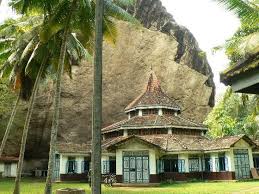Directory
WARANA RAJAMAHA VIHARA
Warana is a majestic, rocky mountain close to Veyangoda, off the Colombo-Kandy road at the Thihariya junction. From Thihariya junction off Nittambuwa, this winding mountain road leads to Kalagedihena where it runs through sprawling rice fields interlaced with coconut plantations. Looming over this is a prominent mountain called Warana in the shape of an elephant's head with its wrinkles carved in the rock. Warana is another name for the elephant. The mountain on its right facing this rock temple is called Miriswattagala.
In front of this Warana Rajamaha Vihara is the Avasa (Priests' residency), a rambling old building with prominent gables.
I was introduced to the Incumbent of this Rock temple - Ven. Dompe Punjananda, a learned Buddhist monk who related the history of this Len Vihara (cave temple). There are altogether 12 rock cave-shelters in this boulder and besides this Avasa, there are two other Viharas.
A commodious Dharamsala (Preaching Hall) stands in the foreground. Though the Tamba Sannasa (a decree inscribed in granting lands by the king) shows many acres of lands gifted to the temple, only fifty acres are now left. A few feet away from the rock temple on its right is a rock outcrop on which are etched a line of faded away Brahmin inscriptions dating back to the 2nd-3rd century B.C. Overlooking this boulder is another prominent mountain called Miriswattagala.
Dr. S. Paranavithana in his book Inscriptions of Ceylon, Part I interprets the Brahmin inscriptions thus: (page 86 - No. 1102 - Warana).
"Bata Maj himas batikabata Tissadatta dne". In English: "The gift of Lord Tissadatta, brother of Lord Magji hima". It appears that Tissadatta, a Rahatanvahanse (an Arahat) who had gifted the lena is a brother of Ven. Mahinda Maha Thera who brought Buddhism to Sri Lanka in the 3rd century B.C.
The cave shelters are divided into two sections - the Meda Vihara and Uda Vihara (the lower and upper terraces). The Meda Vihara, according to local traditions, was said to have been built by King Valagamba of the first century A.D. In our chronicles like the Mahawamsa, it is recorded that King Valagamba had to go into exile when the country was over-run by Chola invaders from South India.
He had taken refuge in ancient rock caves like this one, where he built Viharas, Buddha and other statues. Later he raised an army to fight against these invaders, and draw them out of the country.
In the Meda Vihara is a gallery of 24 finely sculptured Buddha statues - representing the Suvisu Buddha (past and future Buddha’s). Its constructions are attributed to Nissankamalla reign of the 12th century A.D. On his way to Sri Pada, he is said to have stopped here and offered this Suvisu Pooja in stone.











